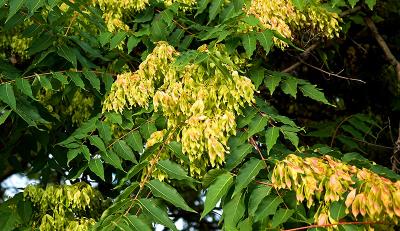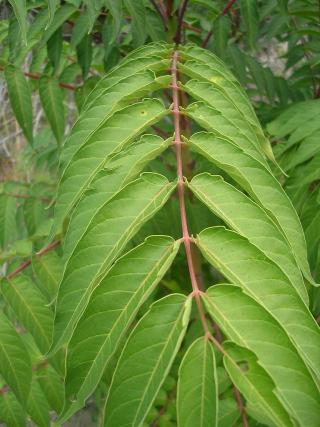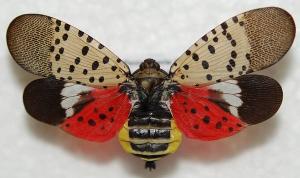Tree of Heaven Removal
A widespread noxious weed hosts a new invasive insect
Identification
Tree-of-heaven (Ailanthus altissima) is a fast-growing, deciduous tree native to China and Taiwan. Growing up to 65 feet or taller, trees develop a taproot and lateral roots, which sprout stems and forms thickets.
- Tree bark is smooth and gray, developing shallow, diamond-shaped fissures as it ages. Its often compared to canteloupe skin.

- Leaves are alternate and pinnately compounds - commonly with 10 to 27 leaflets.
- Stems have large heart to shield-shaped leaf scars.
- Leaflets typically 1.5 to 6 inches long. Margins are smooth except on each side near there base where are are 1 to 3 rounded teeth, each with a gland bump on the lower surface.
- The leaves and stems have a rancid peanut-butter or popcorn-like smell when crushed.
- Male and female flowers occur in clusters on separate trees. Flowers are small and yellowish green.
- Female flowers develop a samara - a single seed in the middle of an oblong, papery wing that can be slightly twisted. Their color ranges from yellowish green, to pinkish tan and brow and are ~ 1 to 2 inches long.
- Female trees may be identified during the winter by clusters of remaining seeds on branch tips.

Look-A-Likes
Smooth Sumac (Rhus glabra) and staghorn sumac (Rhus typhina)
- Large shrubs with many stems. Smooth sumac is native to eastern Washington and grows to ~ 10 feet. Staghorn sumac is not native to Washington and grows to ~ 15 to 20 feet.
- Both have pinnately compound leaves, with leaflets having tooth margins and no glands at the base.
- Upright, dense flower clusters that form dense clusters of hairy reddish fruits (drupes)
Black walnut (Juglans nigra)
- Bark is brown to gray-black and has narrow, deep furrows.
- Pinnately compound leaves with leaflets having tooth margins and no glands at the base.
- Fruit is a walnut, round in shape, and enclosed in a greenish husk.
Spread, Habitat, and Impacts
Tree-of-heaven reproduces by seed and vegetatively spreads by root and stump sprouts. Mature female trees can produce 325,000+ seeds annually.
Tree-of-heaven grows in primarily open habitats, including forest edges, roadsides, riverbanks, and urban areas. Found throughout the state, tree-of-heaven has a higher known distribution in eastern Washington.
Besides being a preferred host for spotted lanternfly, tree-of-heaven can crowd out native vegetation, leach allelochemicals that may inhibit growth of neighboring plants, damage infrastructure, produce pollen that can be an allergen, and cause rashes for certain sensitive individuals.
Control
Whenever possible, control plants as seedlings or young plants, prior to the development of their extensive roots. Do not leave cut stems or stumps on moist soils as they may resprout. Check with your county noxious weed board about disposal options. Contact with plant parts may cause skin irritation and rashes to sensitive individuals, so be sure to wear gloves and protective clothing.
Manual
Seedlings and small plants can be hand-pulled, dug up, or pulled with a weed levering tool. This is best done when the soil is moist. Make sure to remove the roots as remaining fragrments can resprout. Cutting or mowing plants alone will not provide control as stumps and roots will readily resprout.
Herbicide
Timing of treatment is important for success. Apply foliar spray to small plants when leaves are fully emerged, from mid to later growing season. For larger plants, treatments such as basal bark, frill cuts, or stem injection should occur from mid-summer to early fall. Check with your county noxious weed control board and the Pacific Northwest Weed Management Handbook (https://pnwhandbooks.org) for specific herbicide information.
Frequently monitor the area for multiple years, controlling any new seedlings and sprouts. Plant the area with native and/or non-invasive plants to create shade and provide competition to discourage tree-of-heave seedlings and prevent other weeds from establishing.
Spotted Lanternfly
Spotted lanternfly (Lycorma delicatula) is a new and emerging pest in the United States. Its preferred host is tree-of-heaven; however, it can be a serious pest on a wide variety of important agricultural crops, including grapes, fruit trees, hops, and ornamentals.
Spotted Lanternfly Identification
Adults can be found in July and begin laying eggs in September-October. They are 1 inch long and 1/2 inch wide. Forewings are gray with dark spots and venation at the wing tips. Hindwings are red at the base with black and white above. The abdomen is yellow and black. The hindwings and abdomen are hidden when adults are at rest.
hidden when adults are at rest.
Nymphs hatch in April-May and develop through four stages. Early nymphal stages are small (less than 1/2 inch) and black with white spots. The fourth nymphal stage develops read markings and are over 1/2 inch long. Nymphs tend to cluster together and cannot fly.
Eggs are gray-brown and laid in clusters on tree bark or a wide variety of outdoor surfaces and are easily overlooked. Egg masses can be found from September-April.
Spotted Lanternfly Distribution
Spotted lanternfly is currently established in several northeaster states, and the potential for rapid spread across North America is high. Egg clusters and adults can be easily transported by car, rail, or air. Careful inspections of materials before transport will help prevent further spread.
Spotted Lanternfly Impacts
Nymphs and adults damage plants by sucking sap from stems, trunks, and leaves. They also secrete large amounts of honeydew which hosts pathogens such as sooty mold. In Washington, grapes, fruit trees, and hops are most likely to be impacted.
